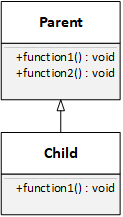 |
class Parent
{
public:
void function1();
void function2();
};
|
class Child : public Parent
{
public:
void function1();
};
|
Polymorphism allows programmers to write programs that can automatically select a member function from a set of candidates. We've studied in detail two of the requirements for polymorphism: inheritance and upcasting. Specifically, we've seen how inheritance and casting affect access to member variables. Before exploring polymorphism, our only remaining task is to understand the effects of inheritance and casting on "regular" or non-polymorphic member functions. For clarity, let's remind ourselves that we are still not dealing with polymorphism but are examining how objects behave when casting is involved. The classes in our previous examples contained only member variables, but we now shift our focus to functions, and our examples reflect that shift.
 |
class Parent
{
public:
void function1();
void function2();
};
|
class Child : public Parent
{
public:
void function1();
};
|
The following code fragment demonstrates how upcasting affects function calls based on these two class specifications. Understanding which function runs in a given situation is crucial to understanding and effectively using polymorphism.
Parent* p1 = new Parent; Child* p2 = new Child; Parent* p3 = new Child; // upcast, Child to Parent // Group 1 p1->function1(); // calls Parent::function1 p1->function2(); // calls Parent::function2 // Group 2 p2->function1(); // calls Child::function1 p2->function2(); // calls Parent::function2 - inherited from Parent // Group 3 p3->function1(); // calls Parent::function1 p3->function2(); // calls Parent::function2
In each example, the compiler can complete the function call binding (i.e., connecting a function call to a function's machine instructions) during the compile and link operations. Computer scientists use the terms compile time binding, early binding, and static binding to refer to this kind of function-call binding. Polymorphism changes how a program completes the function binding.
You must understand this behavior before you continue with the next section, where we take the final step and explore polymorphism.